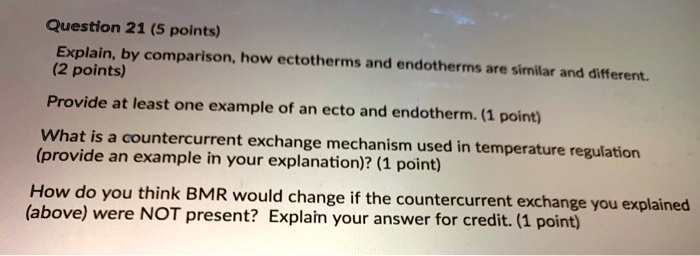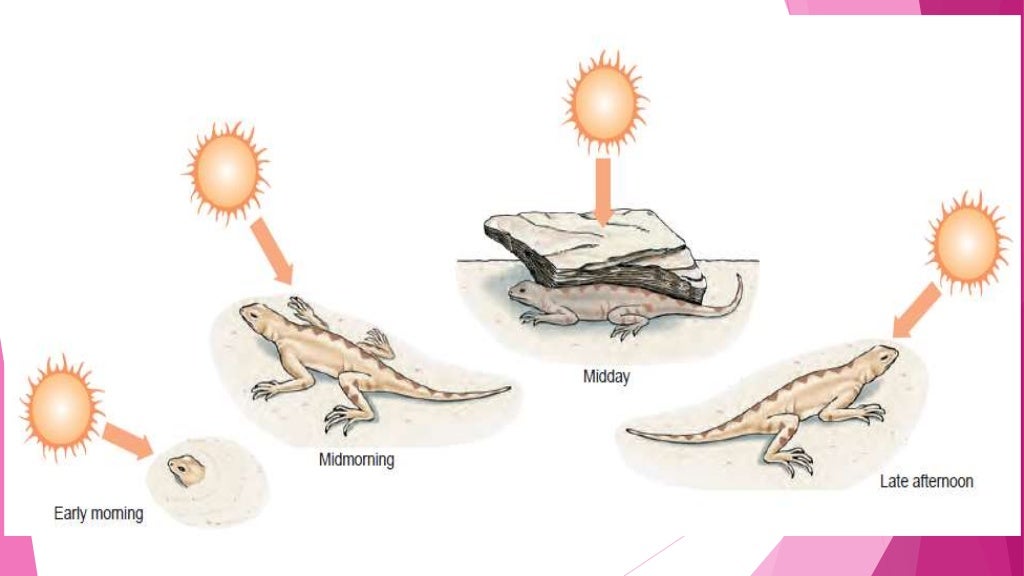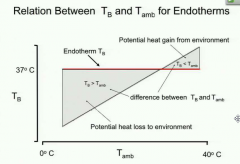Describe How Thermal Regulation Is Different In Ectotherms And Endotherms
Thermal regulation plays a vital role in the survival and functioning of organisms. It refers to the ability of an organism to maintain its body temperature within a certain range, regardless of the environmental conditions. However, the mechanisms of thermal regulation differ between ectotherms and endotherms. In this article, we will explore the differences in thermal regulation between these two groups of organisms and examine how they have evolved to adapt to their environments.
Ectotherms: Relying on the Environment

Ectotherms are organisms that primarily rely on external sources of heat to regulate their body temperature. They do not possess internal mechanisms to generate heat. Instead, ectotherms adjust their body temperature by behaviorally and physiologically manipulating their interactions with the surrounding environment.
Endotherms: Producing Their Own Heat

Endotherms, on the other hand, have evolved the ability to generate heat internally. They possess highly efficient metabolism and cellular respiration processes that allow them to produce heat as a byproduct. This self-generated heat enables endotherms to regulate their body temperature independent of the environmental conditions.
Differences in Thermal Regulation
1. Ectotherms: Adapting to the Environment's Temperature
Ectotherms, such as reptiles, amphibians, and most fish, have limited control over their body temperature. They rely on environmental heat sources to raise their body temperature and behavioral adaptations to cool down. Ectotherms can adjust their behavior, such as basking in the sun or seeking shade, to optimize their body temperature.
2. Endotherms: Homeostasis through Heat Production
Endotherms, including mammals and birds, have the ability to maintain a relatively constant body temperature through internal heat production. This allows them to inhabit various environments, even those with extreme temperature fluctuations. Endotherms utilize adaptations like fur, feathers, and increased metabolic rates to generate and retain heat, ensuring their body temperature remains within the optimal range for physiological processes.
3. Energy Efficiency and Trade-offs
The different mechanisms of thermal regulation in ectotherms and endotherms have trade-offs in terms of energy efficiency. Ectotherms, by relying on external heat sources, require significantly less energy to maintain their body temperature compared to endotherms. This energy efficiency allows ectotherms to allocate resources towards growth, reproduction, and other essential functions rather than solely on heat production and maintenance.
In contrast, endotherms require higher energy inputs to fuel their internal heat production. Energy gained from food is directed towards maintaining body temperature, limiting the resources available for growth and reproduction. However, the ability to regulate body temperature irrespective of the environment provides endotherms with several advantages such as increased activity levels, enhanced cognitive function, and wider ecological niche adaptability.
FAQ: Frequently Asked Questions
Q: Can ectotherms survive in extreme temperatures?
A: Ectotherms have limited ability to cope with extreme temperatures directly. However, they have evolved physiological and behavioral adaptations that help them survive in their respective habitats. For example, some ectotherms can aestivate or hibernate to avoid extreme temperature conditions.
Q: Do endotherms need to consume more food because of their higher metabolic rates?
A: Yes, endotherms require a higher intake of food to fuel their metabolism and heat production. This increased energy requirement is necessary for maintaining body temperature, especially in environments with low ambient temperatures.
Q: Are ectotherms and endotherms equally efficient in utilizing energy?
A: No, ectotherms are generally more energy-efficient compared to endotherms for thermal regulation. Ectotherms rely on external heat sources and can allocate more energy for growth and reproduction. In contrast, endotherms require substantial energy inputs solely for heat production and maintenance.
In conclusion, thermal regulation differs significantly between ectotherms and endotherms. While ectotherms rely on external heat sources and behavioral adaptations, endotherms internally generate heat to regulate their body temperature. These differences have shaped the evolutionary adaptations of these organisms to their respective environments, determining their energy efficiency, activity levels, and ecological niche adaptability.
Temperature Regulation In Ectotherms
 Image Source : www.slideshare.net
Image Source : www.slideshare.net ectotherms ectotherm quia amphibian
PPT - Thermoregulation PowerPoint Presentation - ID:814812
 Image Source : www.slideserve.com
Image Source : www.slideserve.com thermoregulation
The Effect Of Temperature On Viral RNA Synthesis, RNA Secondary
 Image Source : www.researchgate.net
Image Source : www.researchgate.net SOLVED:Describe One Key Environmental Constraint For Ectotherms And One
 Image Source : www.numerade.com
Image Source : www.numerade.com Solved Compare And Contrast Ectothermy And Endothermy? How | Chegg.com
 Image Source : www.chegg.com
Image Source : www.chegg.com Lecture 3 - Body Temperature & Temperature Regulation Flashcards - Cram.com
 Image Source : www.cram.com
Image Source : www.cram.com cram flashcards endotherms
Solved Include Drawings And Examples As Needed. You | Chegg.com
 Image Source : www.chegg.com
Image Source : www.chegg.com SOLVED: Question 21 (5 Points) Explain; By Comparison, How Ectotherms
 Image Source : www.numerade.com
Image Source : www.numerade.com Solved compare and contrast ectothermy and endothermy? how. Solved include drawings and examples as needed. you. Temperature regulation in ectotherms. The effect of temperature on viral rna synthesis, rna secondary. Solved: question 21 (5 points) explain; by comparison, how ectotherms